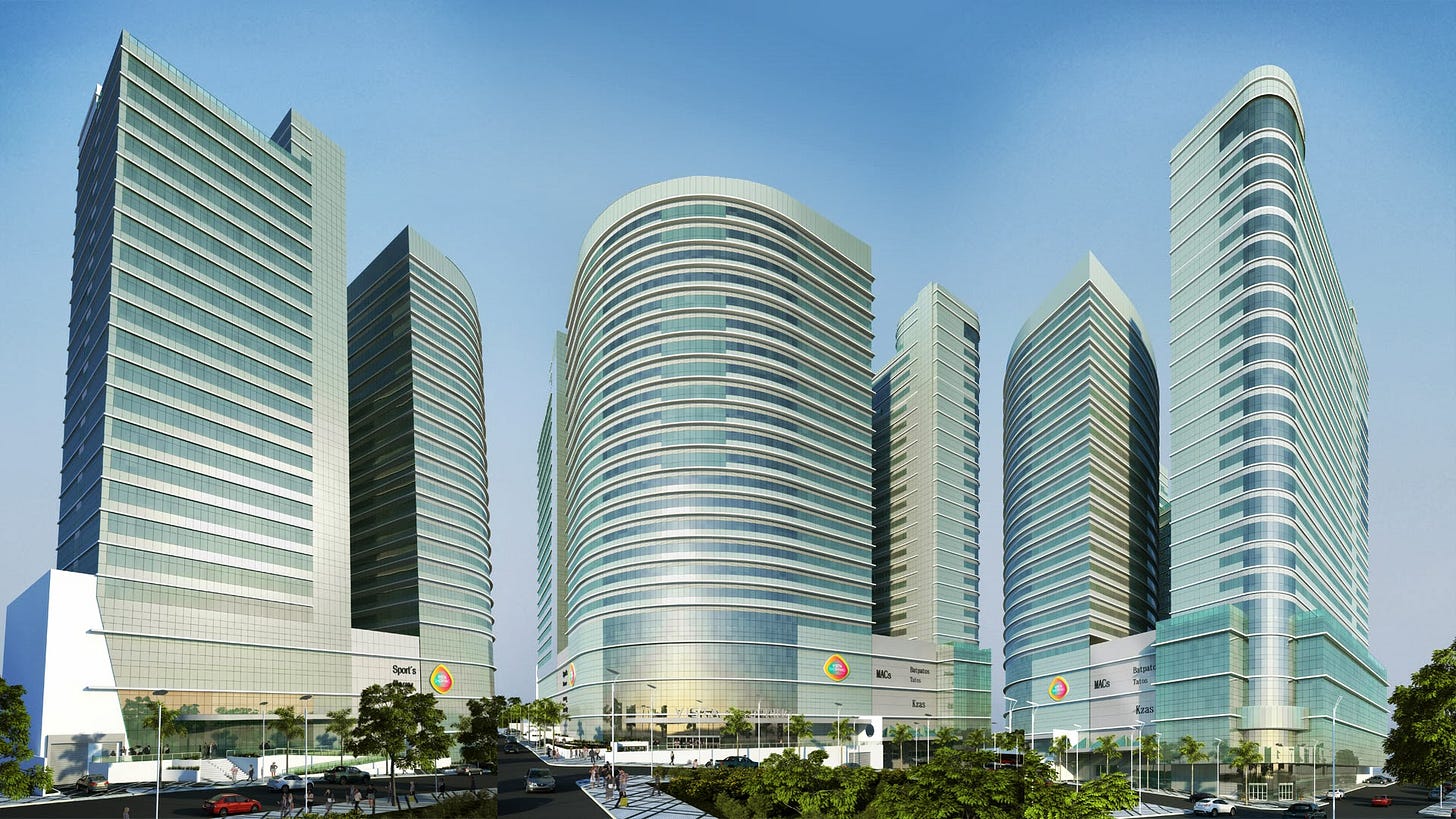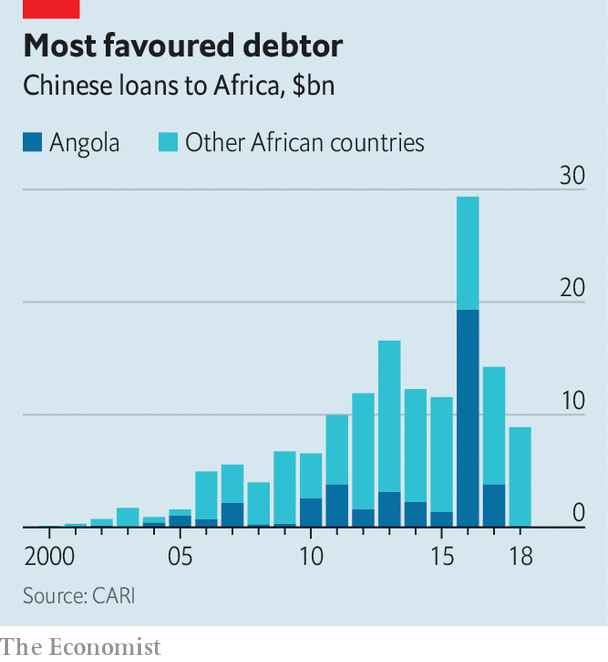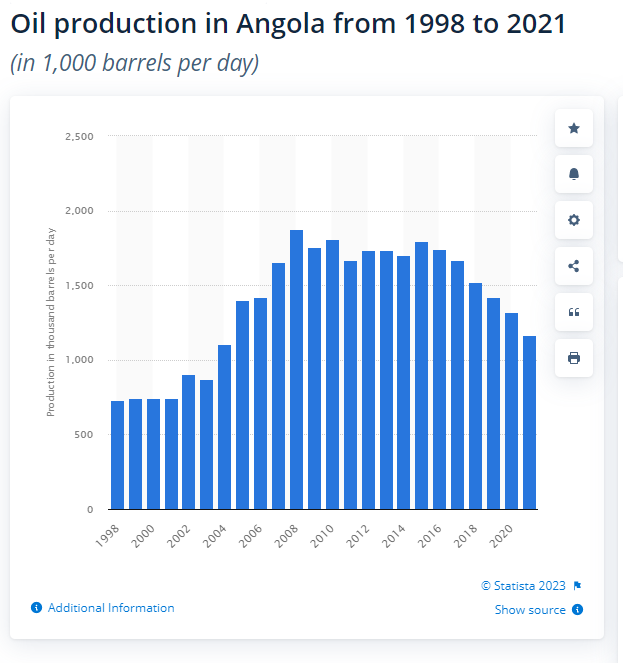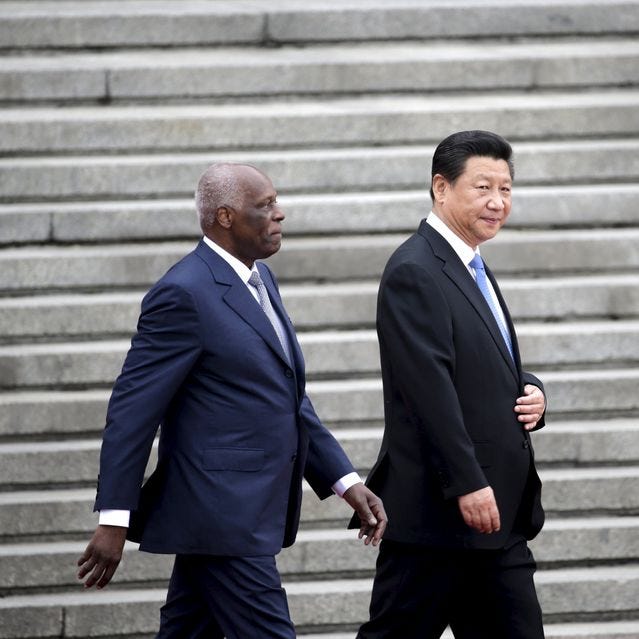The Economic & Geopolitical History of Angola (Old)
The African Vietnam War, Isabel Dos Santos, Credit Suisse, & Chinese investment

Today we are going to talk about Angola. Angola is a petrostate Southwest Coast of Africa with a population of 35M people and a median age of 17 years. Largest ethnic groups are Ovimbundu, Mbundu, and Bakongo (which also live in the Congo nations & Gabon). Angola received independence from Portugal in 1975 and then had a civil war which ended in 2002.
After the civil war, due to Chinese massive growth and demand for oil & commodities for its construction and manufacturing binge, Angola quickly developed from a poor country to temporarily become an upper middle income country between 2012-2014, briefly beating North African nations like Morocco. However, once the North American shale revolution exploded production & Chinese commodity demand tempered after 2014, the demand and price of oil plummeted and so did Angola’s economy. At 2014, Angola had a GDP of $137B, now as of 2022, it lost a fifth of its GDP at $107B. Currently as of 2022, Angola is a lower-middle income country, ranking higher than Cameroon or Cambodia but now lower than than Morocco or Eswatini. In terms of overall human development(healthcare, schooling, & average income per person), the United Nations ranks Angola at 58.6%, which is mid level. This puts Angola in higher footing than Syria, Cameroon, Kenya, or Pakistan.

Angola is also in OPEC and has the 19th highest reserves of oil on earth (8B barrels), with more than half located in the Cabinda province, which is a strip of land detached and above mainland Angola. Angola’s biggest trade partners are China (by far), India, the European Union, and the UAE.
Luanda, the capital, boasts impressive construction sites, business centers, and government buildings that signal growth. But beyond Luanda, Angola struggles with poverty, making Angola a deeply unequal nation.

The Kongo Kingdom & Ngoyo
Around some time in the late 14th/early 15th century the Kongo Kingdom and Ngoyo emerged.
Kongo was ruled by a Manikongo (King of Kongo) who governed through a hierachy of provincial governors and local chiefs. The economy was a subsistence farming economy where people sold yams, millet, copper, and ivory. Ngoyo had a similar economy, but it was less centralized.
In 1483, Portuguese explorers under Diogo Cao arrived and made contact with Kongo. Initially their relationship was based of trade, diplomacy, and missionary activity.
Eventually, the Manikongo, Nzinga a Nkuwu, made formal ties with Portugal. Kongolese ambassadors even went to Portugal.
By 1491, Nzinga a Nkuwu converted to Christianity and took the Christian name Joao. The Kongolese elite became Christian, and Portuguese missionaries made schools and churches along the coast. Portugal sold firearms, clothes, and luxury goods, while Kongo sold slaves, ivory, and copper.
With more firearms, Kongo was able to round up slaves, expand its territory, and gain vassal states (like Kasanze and Kakongo). The African slaves were taken to Brazil to produce sugar.
After the 1884 Berlin conference, Portugal officially colonized the nation. Fast forward to the 1950s, and Portugal found oil in Angola in 1955. The Portuguese oil & gas firm SACOR made a subsidiary SACOR Angola to manage the assets. Angola had a 200K+ Portuguese population and Luanda, Lobito, and Benguela were modern European style cities with newspapers, sports clubs, and museums.
The Portuguese took farm land from the Africans and forced them to grow coffee and palm oil for them.
War of Independence (1961-1974)
While Britain and France were (reluctantly) decolonizing, Portugal dug its heels in its prized colony and increased investing in Angola by building hydroelectric dams and roads. The Portuguese saw Angola more like an “overseas province” more than a colony. The government invested in boosting raw material production, which became a production chain with the end products being built in Portugal. Colonial Angola became a strong exporter of sisal (a plant used to make mats), coffee, cotton, diamonds, iron and eventually oil to Portugal. The Angolans were forced in a system of debt bondage which was enforced by rape, whipping, and violence - “chibalo”.
The native Angolans hated this arrangement and formed political groups to fight Fascist Portugal for independence. The groups were:
UNITA (Union for Total Independence of Angola): Composed mainly of Ovimbundu and shifted from Maoist Communism turned to center right politics, (China, U.S. and Apartheid South Africa funded)
MPLA (The Marxist-Leninist People’s Movement for Liberation of Angola): Mainly composed of the Mixed race Mestizos and the Mbundu tribe (USSR & Cuba funded)
FNLA (National Front for Liberation of Angola): This party was largely Bakongo tribe and anti-communist (US & Mobutu’s Zaire [DRC] funded )
In 1974, Portugal experienced the Carnation Revolution, which put an end to fascist rule under Antonio Salazar. The new Portuguese government granted Angola independence and the former Portuguese firm Angol, which oversaw the oil & gas sector in Angola, came into the hands of the socialist government of Angola, MPLA. The firm Angol was renamed “Sonangol”. The economy has been run by the MPLA party from 1975 to present day.
In 1973, Angolan heavy industry was meeting half of domestic demand. At independence, out of fear of death, over 200k white Portuguese left Angola, leaving barely any teachers, doctors, civil servants, and etc. Portuguese plantation owners abandoned their farms. As a result, Angolan sugar, coffee, and other agricultural goods plummeted in production and didn’t recover from colonial production highs until the year 2000. Out of the 692 factories, only 284 continued to operate. Sites with already bad infrastructure were completely obliterated.
Angolan Civil War/American-Soviet Proxy war (Soviet Communists vs. Nationalists) (1975-2002)
MPLA, UNITA, and FNLA could not decide how they wanted to govern the country, so they decided to kill each other with help from superpowers. The Communist MPLA, led by President Antonio Agostinho da Silva Neto, was funded by The Soviet Union, East Germany, the African National Congress (Nelson’s freedom fighter union), and Cuba. The MPLA quickly destroyed the three branches of government to create one-party rule. African nations and the Soviet bloc acknowledged the MPLA as the rulers of Angola. In addition, the MPLA fought for black freedom in Apartheid South Africa & Namibia.
UNITA & FNLA received support from Apartheid South Africa, Zaire (Mobutu’s Democratic Republic of Congo), China (which now hated the Soviet Union after almost having a war with them and built ties with Richard Nixon), and the United States.
Oil production was concentrated in regions where the socialist party could defend the rigs. After the 1973 Arab-Israeli war, skyrocketing oil prices increased the value of these assets. But Angola lacked skilled labor. So communist Angola worked with Western multinationals like Gulf Oil, Texaco to continue oil production.
President Neto died in 1979, and his successor, Jose Eduardo dos Santos took over. The Angolan communists adopted Soviet policies like abolishing private enterprise, leaving the role of business investment, operations, and distribution to the government. There was little separation between the communist party, the government and the economy.
By the early 90s, the Soviet Union split in to 15 distinct nations and Russia was a starving shell of itself. MPLA abandoned communism, adopted mixed market capitalism, and joined the IMF, which forced Angola to hold a multiparty election in 1992. Some of the government owned enterprises and cooperatives became private enterprises run by entrepreneurs. After Angola had its election, MPLA won with 49.6% of the popular vote and UNITA, being a sore loser, resumed the war. Bill Clinton had no need to back UNITA. since MPLA changed its ideology and America recognized MPLA’s rule on Angola.
In 1996, MPLA’s Angola found the Girasol oil field, and BP, Exxon, Royal Dutch Shell, and others flowed into investing in Angola. Sonangol used to issue concessions and tax collection, but overtime from hiring Italy’s ENI and Algeria’s Sonatrach for training, Sonangol became involved in direct oil production. Sonangol expanded to own businesses in every industry in Angola. Meanwhile, UNITA would steal diamond fields and sell diamonds to fund its war on MPLA’s government.
End of Civil war
By 2001, the South African development community, the UN, and the MPLA declared UNITA a terrorist organization. Then in 2002, the UNITA rebels were defeated, and overall over 1.5M Angolans died. By this time, Angola was dependent on oil. Oil accounted for 90% of the nation’s exports, and oil revenues was 75% of the government’s budget, and half of their GDP. By the end of the civil war a third of the nation lived under $1.9 a day. Farming production was in shambles, Angola imported half its grain from abroad.
Post War Period of Jose Eduardo Santos’ Rule
Oil Production
Oil dominates Angola which kills the manufacturing sector from growing. This is due to the Dutch disease, where the Angola’s currency, the kwanza becomes stronger as a result of oil exports, making domestically produced goods more expensive globally. As a result, Angolan manufacturing is the same proportion of the economy as it was in 1998 during the civil war (5% as of 2021). Most consumer products that Angolans need like machines, refined petrol, and cars, are imported from Europe, UAE, and China instead of bought domestically. During Dutch disease, while manufacturing dies, service and construction should still be strong, since those industries are domestic. However, Angola has outsourced services & construction to Chinese firms and labor.
China’s economic growth caused an oil price boom occurred in the 2000s, which came right in time for Angola to double production from 2000 to 2008 (see graph above: 800K to almost 1.9M barrels per day). Average incomes grew from $590 (poorer than Haitians) per person to $4800 per person(as rich as Armenians). Unfortunately, since the oil revenue is collected by the state, the oil dollars went into Jose’s clique (the military & the political party) more than broad prosperity. However, in 2015 when oil prices declined, so did incomes. Production declined slightly to 1.77 M barrels and has been declining since. The oil firm Sonangol was run by Eduardo’s daughter, Isabel Dos Santos.
Diversification
In 2012, Eduardo made a Sovereign Wealth Fund funded by oil profits just like Saudi Arabia did in 1971. As of 2022, it currently has $2B assets under management (Saudi Arabia has $775B AUM). In addition, the banking, telecoms, construction, beverages, and retail sectors were expanding, fueling a small middle class in Angola. The sovereign wealth fund was run by Eduardo’s son, Jose Filomeno dos Santos.
Chinese Investment
China, which was growing rapidly in the 2000s, appealed to Santos. Santos could go the pro-Western route, where IMF & World Bank loans require “good governance”. Or Santos could go the China route, which doesn’t believe in “meddling in other nation’s internal affairs”. Santos received most of his funding through China. So China under Hu Jintao agreed to fund large scale projects in 2004 in return for oil contracts at discounted prices. The Chinese Development Bank “generously” allows Angola to delay principal repayments until mid 2023.

In 2003, Angola signed an agreement for its first loan backed by crude oil contracts to China. China’s Export-Import Bank loaned $4.4B at a benchmark rate of London Interbank Offered Rate (LIBOR) + 1.5%. Under this agreement, for the debt covered by crude oil, in the first 2 years China received 15K barrels per day, which then decreased to 10K. When the price of oil fell in the financial crisis of 2008, shipments were increased to 100K barrels a day.
In 2008, the Chinese development Bank also provided a new $1.5B loan for the construction of social housing, transportation infrastructure, and agricultural projects.
The China International Fund (CIF) gave cheap loans for the construction of infrastructure, backed with crude oil contracts. CIF gave $9.8B throughout the 2000s to the Chinese International Trust and Investment Corporation (CITIC) for building 215K homes in the capital and across 17 provinces, new huge hospitals & medicines, renovated universities & schools, the creation of an industrial zone in Viana, the construction of a new airport in Luanda, and other projects.
China also financed the purchase of tractors, irrigation systems, and other advanced machines for agriculture in Angola’s provinces of Huambo, Hula, and Moxico. Luckily as oil prices were growing, Angola did not struggle paying debts. Even today, Angola is accelerating debt payments.
With unfettered access to Angola’s oil, Chinese oil firms have actively invested in Angola’s oil sector so Angola can export MOAR OIL. Sonangol and China’s Sinopec formed the joint company Sonangol Sinopec International (SSI) which acquired stakes in existing projects.
Angola’s oil wealth has made it possible for the nation to get cheap loans for postwar reconstruction. But Angola’s economy has not diversified. The country is more dependent on oil than ever.

New President João Lourenço (2017-Present)
The 3rd president, João came in at a bad time oil prices have been under $100 and where western oil project investment has been declining.
Angola needs high oil prices or else Western Internationals like Exxon or Total won’t invest in Angola’s rich offshore basins. Angola has higher capital & operational expenditures needed, not to mention deep water oil exploration are risky investments. The western internationals would rather invest in shale fields in Texas or North Dakota were capital & operational costs are lower. The oil price over the decade barely breaks even or is lower than the capital & operational cost.
In 2018, Joao decided to increase western ties by borrowing $4.5B from the IMF. IMF loans have strings attached removing currency anchorage, adding a value-added tax and selling government firms & assets. The IMF told the Angolan finance minister to sell hundreds of government firms &assets (like auctioning up a diamond mind and the Angolan airline to private investors), but just over 30 have been sold. Angola has also been issuing 9% yields on 10 and 30 year bonds, raising $3B for government projects.
Angola now has a stock market
As of 2022, Angola finally made a stock market called the Luanda stock exchange.
João’s Anti-Corruption Campaign
João Lourenço has been stamping out rampant corruption created by the previous president Jose Eduardo dos Santos. His administration estimates that $24B was looted during Santos’ rule. One of the directors of Sonagol, was Isabel dos Santos, the daughter of Eduardo Dos Santos. She was on Forbes magazine for being Africa’s richest woman until she was caught by João’s administration for using public funds to amass her wealth. Prosecutors alleged that she stole $1.14B from the government owned firm of Sonagol. In addition, Jose Filomeno dos Santos, the son of the former president and head of Angola’s Sovereign Wealth Fund, was jailed for transferring $500M of the fund to the now-defunct, Swiss bank, Credit Suisse.
So far Joao’s policies have been serving whim well since he was reelected in 2022 with 51% of the vote. Transparency international now rates Angola to be fighting corruption. In mid 2010s, Angola was rated among the top 5 most corrupt nations, while now it’s approaching the global average of corruption as of 2022. Hopefully, there will be another oil boom, or other sectors of the economy can expand past its 2014 peak.
One of my biggest takeaways here was that The US did not need to intervene for a nation to abandon communism. After the Angolan communists won the civil war, the communist party abandoned communism on its own accord.
Links are underlined!
Other resources used:
https://carnegieendowment.org/files/Movchan_Report_Final_0328_Print_1.pdf









Nice to see a good African author on substack writing about Africa. There are few and I have searched.
It may be your speciality will be the petrostates but if you have time the SADC states and comment thereon would be if interest to myself.
Angola is an example common to Africa which has hindered the economic development for a long time.
A bad president burns the house. The good president spends his time putting out the fires but doesn't have much time to build a better house as a result of the fire fighting he needs to do. And do on it goes with much economic development missed out.